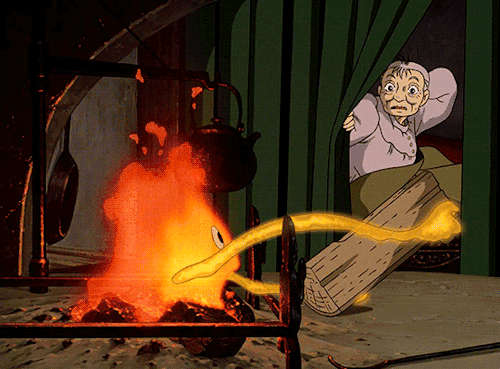According To Legend, Pythagoras Invented A Cup To Prevent His Students From Drinking Too Greedily. If
According to legend, Pythagoras invented a cup to prevent his students from drinking too greedily. If they overfilled the cup, it would immediately drain out all the fluid. The trick works thanks to a U-shaped tube in the center of the cup. As long as the liquid level is below the highest point in the U-tube, only the entrance side of the tube will be filled. As soon as the liquid level in the cup is higher, the weight of all that fluid forces liquid up and around the bend. This kicks off a siphoning effect that pulls all the fluid out. Coincidentally, this is the same way that toilet flushing works! Pulling the handle releases extra water into the bowl that raises the fluid level higher than the highest point in a U-bend. That establishes a siphon, which (provided nothing has clogged the pipe), empties the toilet bowl. (Video credit: Periodic Videos)
More Posts from Smparticle2 and Others





Measuring Cosmic Rays at the Edge of Space

It’s a bird! It’s a plane! It’s a… SuperTIGER?
No, that’s not the latest superhero spinoff movie - it’s an instrument launching soon from Antarctica! It’ll float on a giant balloon above 99.5% of the Earth’s atmosphere, measuring tiny particles called cosmic rays.

Right now, we have a team of several scientists and technicians from Washington University in St. Louis and NASA at McMurdo Station in Antarctica preparing for the launch of the Super Trans-Iron Galactic Element Recorder, which is called SuperTIGER for short. This is the second flight of this instrument, which last launched in Antarctica in 2012 and circled the continent for a record-breaking 55 days.

SuperTIGER measures cosmic rays, which are itty-bitty pieces of atoms that are zinging through space at super-fast speeds up to nearly the speed of light. In particular, it studies galactic cosmic rays, which means they come from somewhere in our Milky Way galaxy, outside of our solar system.

Most cosmic rays are just an individual proton, the basic positively-charged building block of matter. But a rarer type of cosmic ray is a whole nucleus (or core) of an atom - a bundle of positively-charged protons and non-charged neutrons - that allows us to identify what element the cosmic ray is. Those rare cosmic-ray nuclei (that’s the plural of nucleus) can help us understand what happened many trillions of miles away to create this particle and send it speeding our way.

The cosmic rays we’re most interested in measuring with SuperTIGER are from elements heavier than iron, like copper and silver. These particles are created in some of the most dynamic and exciting events in the universe - such as exploding and colliding stars.

In fact, we’re especially interested in the cosmic rays created in the collision of two neutron stars, just like the event earlier this year that we saw through both light and gravitational waves. Adding the information from cosmic rays opens another window on these events, helping us understand more about how the material in the galaxy is created.
Why does SuperTIGER fly on a balloon?

While cosmic rays strike our planet harmlessly every day, most of them are blocked by the Earth’s atmosphere and magnetic field. That means that scientists have to get far above Earth - on a balloon or spacecraft - to measure an accurate sample of galactic cosmic rays. By flying on a balloon bigger than a football field, SuperTIGER can get to the edge of space to take these measurements.

It’ll float for weeks at over 120,000 feet, which is nearly four times higher than you might fly in a commercial airplane. At the end of the flight, the instrument will return safely to the ice on a huge parachute. The team can recover the payload from its landing site, bring it back to the United States, repair or make changes to it, if needed, and fly it again another year!

There are also cosmic ray instruments on our International Space Station, such as ISS-CREAM and CALET, which each started their development on a series of balloons launched from Antarctica. The SuperTIGER team hopes to eventually take measurements from space, too.
Why do we launch from Antarctica?

McMurdo Station is a hotspot for all sorts of science while it’s summer in the Southern Hemisphere (which is winter here in the United States), including scientific ballooning. The circular wind patterns around the pole usually keep the balloon from going out over the ocean, making it easier to land and recover the instrument later. And the 24-hour daylight in the Antarctic summer keeps the balloon at a nearly constant height to get very long flights - it would go up and down if it had to experience the temperature changes of day and night. All of that sunlight shining on the instrument’s array of solar cells also gives a continuous source of electricity to power everything.

Antarctica is an especially good place to fly a cosmic ray instrument like SuperTIGER. The Earth’s magnetic field blocks fewer cosmic rays at the poles, meaning that we can measure more particles as SuperTIGER circles around the South Pole than we would at NASA scientific ballooning sites closer to the Earth’s equator.

The SuperTIGER team is hard at work preparing for launch right now - and their launch window opens soon! Follow @NASABlueshift for updates and opportunities to interact with our scientists on the ice.
Make sure to follow us on Tumblr for your regular dose of space: http://nasa.tumblr.com.

Neuroscientists call for deep collaboration to ‘crack’ the human brain
The time is ripe, the communication technology is available, for teams from different labs and different countries to join efforts and apply new forms of grassroots collaborative research in brain science. This is the right way to gradually upscale the study of the brain so as to usher it into the era of Big Science, claim neuroscientists in Portugal, Switzerland and the United Kingdom. And they are already putting ideas into action.
In a Comment in the journal Nature, an international trio of neuroscientists outlines a concrete proposal for jump-starting a new, bottom-up, collaborative “big science” approach to neuroscience research, which they consider crucial to tackle the still unsolved great mysteries of the brain.
How does the brain function, from molecules to cells to circuits to brain systems to behavior? How are all these levels of complexity integrated to ultimately allow consciousness to emerge in the human brain?
The plan now proposed by Zach Mainen, director of research at the Champalimaud Centre for the Unknown, in Lisbon, Portugal; Michael Häusser, professor of Neuroscience at University College London, United Kingdom; and Alexandre Pouget, professor of neuroscience at the University of Geneva, Switzerland, is inspired by the way particle physics teams nowadays mount their huge accelerator experiments to discover new subatomic particles and ultimately to understand the evolution of the Universe.
“Some very large physics collaborations have precise goals and are self-organized”, says Zach Mainen. More specifically, his model is the ATLAS experiment at the European Laboratory of Particle Physics (CERN, near Geneva), which includes nearly 3,000 scientists from tens of countries and was able (together with its “sister” experiment, CMS) to announce the discovery of the long-sought Higgs boson in July 2012.
Although the size of the teams involved in neuroscience may not be nearly comparable to the CERN teams, the collaborative principles should be very similar, according to Zach Mainen. “What we propose is very much in the physics style, a kind of 'Grand Unified Theory’ of brain research, he says. "Can we do it? Clearly, it’s not going to happen within five years, but we do have theories that need to be tested, and the underlying principles of how to do it will be much the same as in physics.”
To help push neuroscience research to take the leap into the future, the three neuroscientists propose some simple principles, at least in theory: “focus on a single brain function”; “combine experimentalists and theorists”; “standardize tools and methods”; “share data”; “assign credit in new ways”. And one of the fundamental premises to make this possible is to “engender a sphere of trust within which it is safe [to share] data, resources and plans”, they write.
Needless to say, the harsh competitiveness of the field is not a fertile ground for this type of “deep” collaborative effort. But the authors themselves are already putting into practice the principles they advocate in their article.
“We have a group of 20 researchers (10 theorists and 10 experimentalists), about half in the US and half in the UK, Switzerland and Portugal” says Zach Mainen. The group will focus on only one well-defined goal: the foraging behavior for food and water resources in the mouse, recording activity from as much of the brain as possible - at least several dozen brain areas.
“By collaboration, we don’t mean business as usual; we really mean it”, concludes Zach Mainen. “We’ll have 10 labs doing the same experiments, with the same gear, the same computer programs. The data we will obtain will go into the cloud and be shared by the 20 labs. It’ll be almost as a global lab, except it will be distributed geographically.”
Balancing Time and Space in the Brain: A New Model Holds Promise for Predicting Brain Dynamics
For as long as scientists have been listening in on the activity of the brain, they have been trying to understand the source of its noisy, apparently random, activity. In the past 20 years, “balanced network theory” has emerged to explain this apparent randomness through a balance of excitation and inhibition in recurrently coupled networks of neurons. A team of scientists has extended the balanced model to provide deep and testable predictions linking brain circuits to brain activity.
Lead investigators at the University of Pittsburgh say the new model accurately explains experimental findings about the highly variable responses of neurons in the brains of living animals. On Oct. 31, their paper, “The spatial structure of correlated neuronal variability,” was published online by the journal Nature Neuroscience.
The new model provides a much richer understanding of how activity is coordinated between neurons in neural circuits. The model could be used in the future to discover neural “signatures” that predict brain activity associated with learning or disease, say the investigators.
“Normally, brain activity appears highly random and variable most of the time, which looks like a weird way to compute,” said Brent Doiron, associate professor of mathematics at Pitt, senior author on the paper, and a member of the University of Pittsburgh Brain Institute (UPBI). “To understand the mechanics of neural computation, you need to know how the dynamics of a neuronal network depends on the network’s architecture, and this latest research brings us significantly closer to achieving this goal.”
Earlier versions of the balanced network theory captured how the timing and frequency of inputs—excitatory and inhibitory—shaped the emergence of variability in neural behavior, but these models used shortcuts that were biologically unrealistic, according to Doiron.
“The original balanced model ignored the spatial dependence of wiring in the brain, but it has long been known that neuron pairs that are near one another have a higher likelihood of connecting than pairs that are separated by larger distances. Earlier models produced unrealistic behavior—either completely random activity that was unlike the brain or completely synchronized neural behavior, such as you would see in a deep seizure. You could produce nothing in between.”
In the context of this balance, neurons are in a constant state of tension. According to co-author Matthew Smith, assistant professor of ophthalmology at Pitt and a member of UPBI, “It’s like balancing on one foot on your toes. If there are small overcorrections, the result is big fluctuations in neural firing, or communication.”
The new model accounts for temporal and spatial characteristics of neural networks and the correlations in the activity between neurons—whether firing in one neuron is correlated with firing in another. The model is such a substantial improvement that the scientists could use it to predict the behavior of living neurons examined in the area of the brain that processes the visual world.
After developing the model, the scientists examined data from the living visual cortex and found that their model accurately predicted the behavior of neurons based on how far apart they were. The activity of nearby neuron pairs was strongly correlated. At an intermediate distance, pairs of neurons were anticorrelated (When one responded more, the other responded less.), and at greater distances still they were independent.
“This model will help us to better understand how the brain computes information because it’s a big step forward in describing how network structure determines network variability,” said Doiron. “Any serious theory of brain computation must take into account the noise in the code. A shift in neuronal variability accompanies important cognitive functions, such as attention and learning, as well as being a signature of devastating pathologies like Parkinson’s disease and epilepsy.”
While the scientists examined the visual cortex, they believe their model could be used to predict activity in other parts of the brain, such as areas that process auditory or olfactory cues, for example. And they believe that the model generalizes to the brains of all mammals. In fact, the team found that a neural signature predicted by their model appeared in the visual cortex of living mice studied by another team of investigators.
“A hallmark of the computational approach that Doiron and Smith are taking is that its goal is to infer general principles of brain function that can be broadly applied to many scenarios. Remarkably, we still don’t have things like the laws of gravity for understanding the brain, but this is an important step for providing good theories in neuroscience that will allow us to make sense of the explosion of new experimental data that can now be collected,” said Nathan Urban, associate director of UPBI.








I’m never gonna finish this meme
5 cartoons/anime; 1/5 Spirited Away

Making twisted semiconductors for 3-D projection
A smartphone display that can produce 3-D images will need to be able to twist the light it emits. Now, researchers at the University of Michigan and the Ben-Gurion University of the Negev have discovered a way to mass-produce spiral semiconductors that can do just that.
Back in 1962, University of Michigan engineers E. Leith and J. Upatnieks unveiled realistic 3-D images with the invention of practical holography. The first holographic images of bird on a train were made by creating standing waves of light with bright and dark spots in space, which creates an illusion of material object. It was made possible by controlling polarization and phase of light, i.e. the direction and the timing of electromagnetic wave fluctuations.
The semiconductor helices created by U-M-led team can do exactly that with photons that pass through, reflected from, and emitted by them. They can be incorporated into other semiconductor devices to vary the polarization, phase, and color of light emitted by the different pixels, each of them made from the precisely designed semiconductor helices.
Read more.
-
 human331279 liked this · 4 years ago
human331279 liked this · 4 years ago -
 techjum reblogged this · 4 years ago
techjum reblogged this · 4 years ago -
 viibean-blog liked this · 6 years ago
viibean-blog liked this · 6 years ago -
 suatmathteacher-blog liked this · 6 years ago
suatmathteacher-blog liked this · 6 years ago -
 princeaquiladei liked this · 6 years ago
princeaquiladei liked this · 6 years ago -
 gouachevalier reblogged this · 6 years ago
gouachevalier reblogged this · 6 years ago -
 13thpythagoras reblogged this · 6 years ago
13thpythagoras reblogged this · 6 years ago -
 13thpythagoras liked this · 6 years ago
13thpythagoras liked this · 6 years ago -
 mytrashsstuff liked this · 6 years ago
mytrashsstuff liked this · 6 years ago -
 victorwilt liked this · 7 years ago
victorwilt liked this · 7 years ago -
 banjatheonion liked this · 8 years ago
banjatheonion liked this · 8 years ago -
 neon-ceiling reblogged this · 8 years ago
neon-ceiling reblogged this · 8 years ago -
 neon-ceiling liked this · 8 years ago
neon-ceiling liked this · 8 years ago -
 velvetsunset reblogged this · 8 years ago
velvetsunset reblogged this · 8 years ago -
 psychedelicsynergy liked this · 8 years ago
psychedelicsynergy liked this · 8 years ago -
 thingsmydadmightlike-blog reblogged this · 8 years ago
thingsmydadmightlike-blog reblogged this · 8 years ago -
 nothingbutsunglasses liked this · 8 years ago
nothingbutsunglasses liked this · 8 years ago -
 fluidity reblogged this · 8 years ago
fluidity reblogged this · 8 years ago -
 sworntoptimism reblogged this · 8 years ago
sworntoptimism reblogged this · 8 years ago -
 parable626 liked this · 8 years ago
parable626 liked this · 8 years ago -
 o-set reblogged this · 8 years ago
o-set reblogged this · 8 years ago -
 greenarsonist liked this · 8 years ago
greenarsonist liked this · 8 years ago -
 hoss-delgeezy liked this · 8 years ago
hoss-delgeezy liked this · 8 years ago -
 silcrates liked this · 8 years ago
silcrates liked this · 8 years ago -
 roan13 reblogged this · 8 years ago
roan13 reblogged this · 8 years ago -
 alaskanboyfriend reblogged this · 8 years ago
alaskanboyfriend reblogged this · 8 years ago -
 azhdarcho reblogged this · 8 years ago
azhdarcho reblogged this · 8 years ago -
 chowdernut-blog liked this · 8 years ago
chowdernut-blog liked this · 8 years ago -
 rightrevjeff-blog liked this · 8 years ago
rightrevjeff-blog liked this · 8 years ago -
 napszemuvegbe reblogged this · 8 years ago
napszemuvegbe reblogged this · 8 years ago -
 tomanon-blog1 reblogged this · 8 years ago
tomanon-blog1 reblogged this · 8 years ago -
 marcosm-onofre reblogged this · 8 years ago
marcosm-onofre reblogged this · 8 years ago -
 marcosm-onofre liked this · 8 years ago
marcosm-onofre liked this · 8 years ago -
 gentianablue reblogged this · 8 years ago
gentianablue reblogged this · 8 years ago -
 ayeforbeauty liked this · 8 years ago
ayeforbeauty liked this · 8 years ago -
 ponkita reblogged this · 8 years ago
ponkita reblogged this · 8 years ago -
 gonzalezmanuelr liked this · 8 years ago
gonzalezmanuelr liked this · 8 years ago -
 joqatana reblogged this · 8 years ago
joqatana reblogged this · 8 years ago -
 zanshinart reblogged this · 8 years ago
zanshinart reblogged this · 8 years ago -
 kalikatze liked this · 8 years ago
kalikatze liked this · 8 years ago -
 quilleye liked this · 8 years ago
quilleye liked this · 8 years ago
